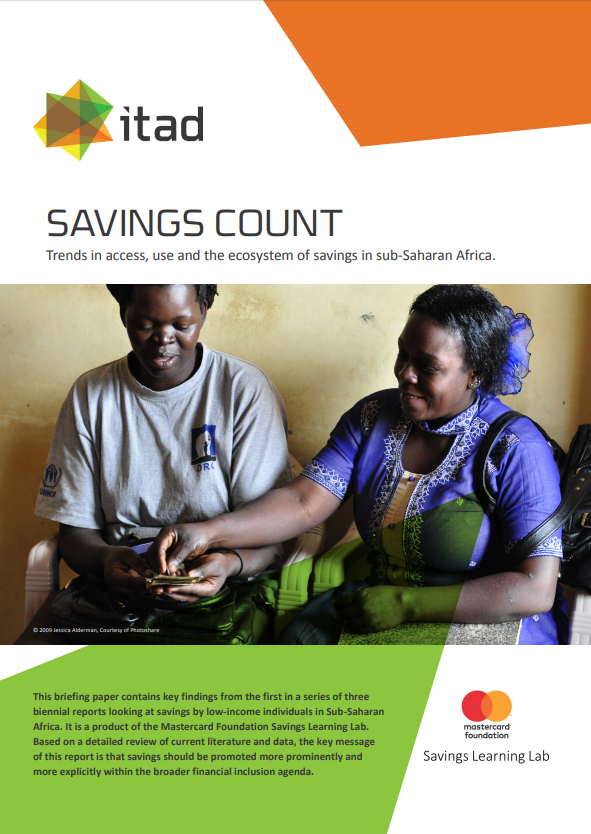This week is Financial Inclusion Week and today is World Savings Day. In recognition of these concurrent days of reflection and support, we would like to use this digital space to discuss our work at the Savings Learning Lab, where we set out to better understand the state of access to, and use of, savings in Sub-Saharan Africa (SSA). What we have learned will help prioritize and contextualize our work over the next few years.
The resulting report, Savings Count, provides a comprehensive synthesis of trends in demand and supply of savings services in SSA. It discusses behavioral trends in saving and barriers to saving, the range of providers and approaches that have made a difference, key policies and regulatory factors important to promote savings, as well as areas of progress, areas in which promising work is underway, and areas where significant progress is required.
Specifically, we set out to ask and answer the following questions.
Are savings part of the financial inclusion success story?
Unfortunately, it doesn’t look like savings have increased at the same rate as access to formal finance.
According to the 2017 Global Findex, in SSA, despite an impressive increase in account ownership from 23 to 43 percent since 2011, the percentage of people who saved money with a formal financial institution stagnated at a low of around 15 percent.
This is concerning. We now know with certainty that the consistent use of financial services can help the world’s poorest people better manage risks, step out of poverty, and build a better life. Strong evidence indicates that savings are an essential part of this package. And while savings rates are higher in SSA than in other developing regions, they are still much lower than in higher-income regions. The persistence of dormant accounts and infrequent use of digital savings – along with poor households’ predominant use of informal savings mechanisms – indicate that people, particularly the poor, continue to face significant barriers to formal saving.
Is there a demand from clients? Or is savings no longer important in the rapidly changing world of financial services?
Our research shows there is a demand and that savings are as important as ever.
Savings are critical for poor people’s consumption smoothing, risk management and financing of important life goals such as education and starting a business. As an industry, we have made significant advances in understanding the impact of savings on customers in key areas such as income, consumption, resilience and food security. We now have a solid understanding of savings behaviors, needs and preferences, of how poor manage their money and what savings mechanisms work best for them. Savings are also good for financial service providers’ bottom lines and are required for economic growth.
Who serves this market and what are their difficulties in providing the services?
The low-income savings market is served by a range of providers such as banks, microfinance institutions, savings and credit cooperatives, and mobile money providers. All providers continue to face challenges in reaching this market segment. This is because poor people tend to keep small balances, transact often and live and work far from traditional banking outlets. Despite the challenges, significant advances have been made in reaching poor people through alternative delivery channels, the rise of digital financial services, the proliferation of linking savings groups to formal finance, and the use of customer-centric approaches. However, providers continue to struggle to serve this population segment with appropriate savings products. They face a number of challenges, including high costs of providing services and low profit margins, insufficient understanding of their clients’ behaviors, the distance of clients from branches, and product offerings that do not meet client needs.
If savings are so important, then what are governments doing to promote it?
The promotion of savings is strongly influenced by government regulation and financial inclusion policies. For example, regulation can determine if certain types of financial service providers can mobilize savings by obtaining deposit-taking licenses, or whether providers can mobilize savings from clients who may not meet all the required identification documents – by allowing for tiered KYC requirements.
Our research shows that countries in SSA employ a range of policy and regulatory initiatives that can help promote savings for low-income clients. These include the widespread adoption of national financial inclusion strategies, the implementation of regulation of e-money funds and the widespread regulation allowing the use of agents to facilitate account opening. Significant work in progress also exists on implementing regulations supporting simplified customer due diligence requirements and enforcement of customers’ ability to receive account information at no cost. However, the uneven prevalence of these examples in the region indicates that continued progress is still needed.
Our main conclusion after unpacking the data and evidence?
There is a need for savings to be promoted more prominently and more explicitly within the broader financial inclusion agenda.
"There is a need for savings to be promoted more prominently and more explicitly within the broader financial inclusion agenda."
Increasing poor people’s ability to use savings mechanisms effectively is fundamental to shifting the industry’s focus from access alone to financial health and meaningful financial inclusion. And while the numbers don’t look so great yet, we believe that collectively as an industry we can make savings work! Our confidence is based on what we identified as existing advances along with promising work in progress in high impact areas, coupled with recommendations of where additional progress will make a significant difference.
We invite you to read our report and to join us in our effort to help close the gap in savings.
Editor’s Note: Like what you read? Listen to SEEP’s Financial Inclusion Week podcast, Navigating the Evidence on Savings-Focused Financial Inclusion, about a searchable, interactive evidence map that provides consolidated access to relevant evidence related to savings-focused financial inclusion.


